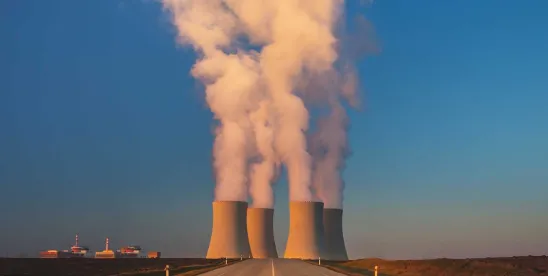As a firm that has spent years deep in the trenches of renewable energy – helping clients navigate the complex landscape of project development, financing, and M&A – we’ve seen this industry evolve at lightning speed. Technologies once considered fringe or cost-prohibitive have become everyday tools in the clean energy toolkit. And if current trends continue, we will be saying the same thing about advanced nuclear energy – and soon. While traditional nuclear has long existed alongside renewables on a separate track, recent developments suggest it’s time for those of us in the clean energy world to take a closer look, not as a replacement for wind, solar or storage, but as a complementary and increasingly indispensable part of the path to net zero. So, if you’re still clutching your pearls at the mere mention of “nuclear,” we invite you to read on.
The Reality: Climate Targets Are Tight. Nuclear Helps Close the Gap.
Whether you’re looking at reports from the International Energy Agency (IEA), Intergovernmental Panel on Climate Change (IPCC), the Paris Agreement or the net zero strategies of other developed countries, the message is resoundingly the same: we are unlikely to reach climate goals anywhere near on time without rapid deployment of nuclear energy. Nuclear energy, specifically modernized Light Water Reactors (LWRs) and next-generation Small Modular Reactors (SMRs), is being included in more integrated clean energy planning. These technologies are carbon-free, firm and dispatchable, often sited closer to demand, and increasingly backed by private capital and government support.
The First Wave: Safer, More Efficient LWRs
What’s coming online first isn’t a dramatic shift from the past, but a smarter, safer, more streamlined version of it. Modern LWRs (like the one being restarted at Palisades in Michigan) benefit from modern safety enhancements, digital monitoring systems and stricter oversight, making them safer and more resilient than older plants. This isn’t theoretical—it’s happening now, with public and private funding support. Repowering closed plants, expanding existing plants with modular advanced nuclear systems, and converting coal plants into nuclear are the lowest-hanging fruit (given existing infrastructure, interconnection and permitting) and these will be the among the first projects to get done with federal and other public funds.
The Second Wave: SMRs, Microreactors, and Behind-the-Meter Opportunities
Beyond LWRs, SMRs and microreactors offer a more flexible nuclear option for a variety of use cases such as industrial co-location, remote communities, data centers and microgrids. There’s growing interest in nuclear for behind-the-meter applications—offering round-the-clock, emissions-free baseload power to facilities with high resilience or ESG demands. Notably, large technology and manufacturing companies have publicly expressed interest in developing or purchasing clean nuclear power for these purposes.
SMRs are widely expected to enter commercial operation in the early 2030s. For instance, the Tennessee Valley Authority (TVA) has applied for a construction permit for a BWRX-300 at the Clinch River site – this is targeting COD by 2033. Similarly, Google-backed projects involving Kairos Power aim to have demonstration reactors operational by 2030, supporting major AI data centers. Meanwhile, microreactors, which are designed to be very small, transportable, and remotely operated, are beginning experimental deployment even sooner. DOE’s DOME test bed at Idaho National Laboratory is slated to host the first fueled microreactor experiments starting in spring 2026, with fully operational microreactors like the DOE-supported MARVEL, which is expected to be online by 2027. These timelines reflect a broader strategy to see commercial microreactor deployment around 2030 once regulatory, licensing and supply chain hurdles are resolved.
Ultimate Goal: Fusion
While advanced nuclear fission is powering the near-term nuclear revival, nuclear fusion remains the holy grail of clean power. Fusion replicates the process that powers the sun, offering limitless, carbon-free energy with no risk of meltdown and virtually no long-lived waste. Though commercial deployment is still on the horizon, timelines are accelerating. Several fusion projects are currently underway – one with Helion Energy (backed by Sam Altman and partnered with Microsoft) has started construction in Malaga, Washington and is aiming to start powering Microsoft data centers in 2028. The massive international ITER project in France (the world’s largest fusion experiment) expects to achieve first plasma by 2035. Google recently signed one of the world’s first-ever PPAs for fusion energy with Commonwealth Fusion Systems, covering 200MW from CFS’s future ARC fusion plant in Chesterfield County, Virginia, which is expected to achieve COD in the early 2030’s. Further, DOE’s Milestone-Based Fusion Development Program is already funding eight U.S.-based fusion companies, accelerating prototype and pilot-stage progress toward commercialization between 2030-2035. If successful, fusion will be a game-changing, limitless source of clean energy – any getting there starts with saying yes to smart nuclear now.
Moving Forward
For developers, investors, utilities, and advisors already working in renewables, this moment presents an opportunity—not a competition. Many of the skills, networks, and tools used to build solar and wind portfolios translate well to advanced nuclear, such as: siting and permitting experience, grid interconnection strategy, tax credit structuring, and infrastructure and community engagement. In short, although we are a number of years away from commercial financing of nuclear projects, clean energy professionals already have the playbook and advanced nuclear will soon become another page in it.
The technology is here. The market interest is growing. And for those who want to be part of building what’s next, the door is opening.




 />i
/>i

